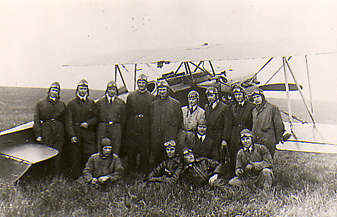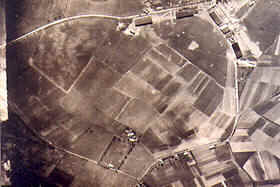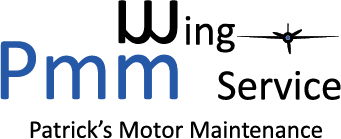The history of Schaffen airfield
In the second half of WWI, the Germans expropriate about 60 hectares of grass-land in Schaffen. They build 4 airplane-hangars on it. The end of WWI meant also the end of aviation in Schaffen. Late 1918, the Belgian army concentrated all aviation activities at the 'big' airfield, the Germans constructed, in Evere. Later they even moved to Krefeld in Germany. All though the Germans left dozens of airfields behind, finding a good and practical site for post-war military aviation was not an easy task. Many of these airfield were destroyed by the local civilians. Those airfields that where saved couldn't always be protected from further plundering by civilians. Fortunately, Schaffen was one of the airfields that could be saved. The French were able to occupy the airfield a short time after the German retreat. They established a depot but they didn't use the 60 hectares as an airfield.
Only in 1919, the Belgian army 'discovered' the airfield. In June 1919, mayor Hanegreefs received a telegram of the Ministry of War, asking him to mow the grass...
That summer, one reconnaissance squadron and three fighter squadrons of the former Jacquet fighter-group landed at Schaffen airfield. From July 1919, everybody could admire the Hanriot HD's, Camels, Spad Sp 13C1's, Spad Sp 11A2 and also the Fokker DVII's. Almost instantly, the airfield was extended with 40 more hectares. A range was laid out where pilots could practice their shooting skills. Because the airfield was mainly occupied by the Jacquet fighter-group, the airfield got named "Kwartier Willy Coppens de Houthulst", after Willy Coppens, the biggest aviation hero Belgian Military Aviation has ever produced. Willy Coppens won 37 dogfights and was at that time recovering of his crash. German artillery shot him down and his leg needed to be amputated.

2nd Squadron 'Schotse Distel' Airmen.
In 1921, the authorities decided to invest in the lay-out and restoring of airfields for the Belgian Military Airforce. This was coupled with the increase of number of squadrons and purchase of new airplanes. Reconnaissance squadrons were based at Bierset, Haren and Goetsenhoven. The number of fighter-squadrons was extended to four. Based at Schaffen airfield were 'Schotse Distel' and 'Comeet'. 'Witte-' and 'Rode Cocotte' were based in Nivelles.
Then, nothing spectacular happened for a while. The fighter-squadrons changed their old airplanes for SABCA-build Nieuport N28C1's, Czechoslovakian Avia BH21's and later for Fairey Fireflies. Eventually, in 1937 these planes were replaced by Gloster Gladiators at the 1st fighter-squadron 'Comeet' and in 1939 by Hawker Hurricanes in the 2nd fighter-squadron 'Schotse Distel'. The two squadrons based at Schaffen airfield became part of the 2nd airforce regiment that in total held 6 squadrons.
In the mean time, the German war-machine started to move again. Austria and Czechoslovakia were annexed unpunished. Then, when the German army invaded Poland, France and Great-Britain declared war to Germany. Between this declaration of war and the escalation of hostile activities in the west, the fighter-squadrons were supposed to keep all intruders, English and French include, out of the Belgian skies. One German JU 52 and one British Whitley were forced to land. One He 111 of the German Luftwaffe was shot down by three Gladiators. The Schaffen fighters lost one Hurricane during a dogfight and two Gloster Gladiators in accidents.

Line up of Fairey Fireflies.
May 10th 1940...
Four fighter-squadrons were concentrated at Schaffen airfield. This day was crucial. In total 50 planes were partially grouped, partially scattered over the airfield. Some time after midnight the alert sounded. Nothing happened. According to the plans, the Gladiators and the Hurricanes should leave on a mission over Beverlo and Diest. But this didn't happen. The German aggressor was able to destroy two squadrons on the ground. Only a squadron Fireflies and the 1st squadron Gladiators escaped. This was only a stay of execution. One day later, some of them were lost during dogfights over the Albertkanaal. The rest was destroyed on the ground. The war ended here for the proud Schaffen fighters.
During the summer of 1940, the airfield changed into a huge building site. Germans started constructing airplane 'boxes' and clean up the mess they made. A training unit of Stukageschwader 1 occupied the airfield. January 14th in 1942, this unit abandoned and blocked the airfield to prevent it from being used. After the bombing on April 5th in 1943 of the "Erlawerk VII" at Mortsel, the airfield got a new function. This time as "Frontreparatur Betrieb", a front repair facility. Here the damaged rudders of Messerschmitt ME 109's were repaired.
Eastern-Monday, April 10th 1944.
American B17's dropped 179 ton of bombs on the airfield and the neighbouring villages. This bombardment meant the end of German activities at Schaffen airfield. Diest was liberated on September 6th 1944 by the British army. The code B64 was assigned by the British and fifteen days later the 168 Recce Sqd RAF started its operations from here. More RAF squadrons were to follow.
The Belgian army returned in March 1946. The elementary aviation school settled down at Schaffen. In May 1947, the para's joined. Four years later, in June 1950, the elementary aviation school, EVS, moved from Schaffen to Goetsenhoven, leaving the para's behind. Since then, the para training centre was located at Schaffen. In 1962 the airfield was extended towards Fort Leopold and a control-tower was built. Nowadays, the Schaffen airfield is located on a terrain of 1700 meter long and 700 meters wide.
Some more highlights :
September 11th,1947 : First para-dropping from a Belgian Dakota.
November 28th, 1947 : First para-drop from 'the balloon'.

Aerial of Schaffen Airfield.








